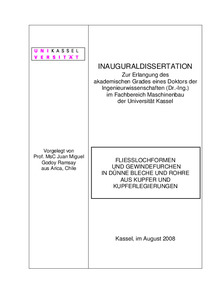| dcterms.abstract | This thesis in Thermal Flow Drilling and Flowtap in thin metal sheet and pipes of copper and copper alloys had as objectives to know the comportment of copper and copper alloys sheet metal during the Thermal Flow Drill processes with normal tools, to know the best Speed and Feed machine data for the best bushing quality, to known the best Speed for Form Tapping processes and to know the best bush long in pure copper pipes for water solar interchange equipment.
Thermal Flow Drilling (TFD) and Form Tapping (FT) is one of the research lines of the Institute of Production and Logistics (IPL) at University of Kassel. At December 1995, a work meeting of IPL, Santa Catarina University, Brazil, Buenos Aires University, Argentine, Tarapacá University (UTA), Chile members and the CEO of Flowdrill B.V. was held in Brazil. The group decided that the Manufacturing Laboratory (ML) of UTA would work with pure copper and brass alloys sheet metal and pure copper pipes in order to develop a water interchange solar heater. The Flowdrill BV Company sent tools to Tarapacá University in 1996. In 1999 IPL and the ML carried out an ALECHILE research project promoted by the DAAD and CONICyT in copper sheet metal and copper pipes and sheet metal a-brass alloys.
The normal tools are lobed, conical tungsten carbide tool. When rotated at high speed and pressed with high axial force into sheet metal or thin walled tube generated heat softens the metal and allows the drill to feed forward produce a hole and simultaneously form a bushing from the displacement material. In the market exist many features but in this thesis is used short and longs normal tools of TFD.
For reach the objectives it was takes as references four qualities of the frayed end bushing, where the best one is the quality class I.
It was used pure copper and a-brass alloys sheet metals, with different thickness. It was used different TFD drills diameter for four thread type, from M-5 to M10. Similar to the Aluminium sheet metals studies it was used the predrilling processes with HSS drills around 30% of the TFD diameter (1,5 – 3,0 mm D). In the next step is used only 2,0 mm thick metal sheet, and 9,2 mm TFD diameter for M-10 thread. For the case of pure commercial copper pipes is used for ¾” inch diameter and 12, 8 mm (3/8”) TFD drill for holes for 3/8” pipes and different normal HSS drills for predrilling processes. The chemical sheet metal characteristics were takes as reference for the material behaviour. The Chilean pure copper have 99,35% of Cu and 0,163% of Zinc and the Chilean a-brass alloys have 75,6% of Cu and 24,0% of Zinc. It is used two German a-brass alloys; Nº1 have 61,6% of Cu, 36,03 % of Zinc and 2,2% of Pb and the German a-brass alloys Nº2 have 63,1% of Cu, 36,7% of Zinc and 0% of Pb.
The equipments used were a HAAS CNC milling machine centre, a Kistler dynamometer, PC Pentium II, Acquisition card, TESTPOINT and XAct software, 3D measurement machine, micro hardness, universal test machine, and metallographic microscope.
During the test is obtained the feed force and momentum curves that shows the material behaviour with TFD processes. In general it is take three phases.
It was possible obtain the best machining data for the different sheet of copper and a-brass alloys thick of Chilean materials and bush quality class I. In the case of a-brass alloys, the chemical components and the TFD processes temperature have big influence. The temperature reach to 400º Celsius during the TFD processes and the a-brass alloys have some percents of Zinc the bush quality is class I. But when the a-brass alloys have some percents of Lead who have 200º C melting point is not possible to obtain a bush, because the Lead gasify and the metallographic net broke.
During the TFD processes the recrystallization structures occur around the Copper and a-brass alloy bush, who gives more hardness in these zones. When the threads were produce with Form Tapping processes with Flowtap tools, this hardness amount gives a high limit load of the thread when hey are tested in a special support that was developed for it.
For eliminated the predrilling processes with normal HSS drills it was developed a compound tool. With this new tool it was possible obtain the best machining data for quality class I bush.
For the copper pipes it is made bush without predrilling and the quality class IV was obtained. When it is was used predrilling processes, quality classes I bush were obtained. Then with different HSS drill diameter were obtained different long bush, where were soldering with four types soldering materials between pipes with 3/8” in a big one as ¾”. Those soldering unions were tested by traction test and all the 3/8” pipes broken, and the soldering zone doesn’t have any problem.
Finally were developed different solar water interchange heaters and tested.
As conclusions, the present Thesis shows that the Thermal Flow Drilling in thinner metal sheets of cooper and cooper alloys needs a predrilling process for frayed end quality class I bushings, similar to thinner sheets of aluminium bushes. The compound tool developed could obtain quality class I bushings and excludes predrilling processes.
The bush recrystalization, product of the friction between the tool and the material, the hardness grows and it is advantageous for the Form Tapping.
The methodology developed for commercial copper pipes permits to built water solar interchange heaters. | eng |

